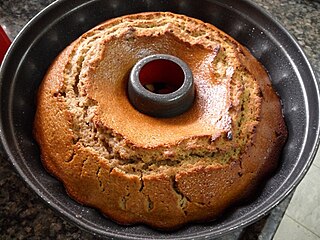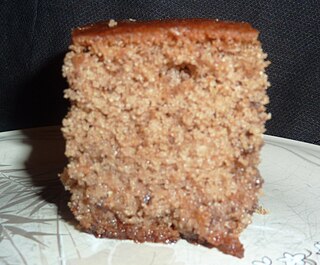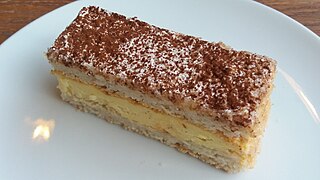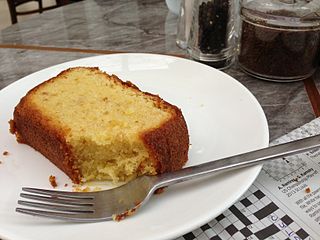
An ontbijtkoek, peperkoek or kruidkoek is a Dutch and Flemish spiced cake. Rye and dark brown basterdsuiker are its most important ingredient, coloring the cake light brown. It is often spiced with cloves, cinnamon, ginger, succade and nutmeg. Several parts of the Netherlands have their own local recipe, of which the most famous is oudewijvenkoek, which is mostly eaten in the northern regions, and is flavored with aniseed. Ontbijtkoek is traditionally served at breakfast with a thick layer of butter on top, as a replacement for bread, however, due to its sweet taste it is also served as a snack. It is best eaten the day after it is baked, but has a shelve life of several weeks at room temperatures, without it spoiling, due to the pH, sugar content and used spices.

Flies' graveyard and flies' cemetery are nicknames used in various parts of the United Kingdom for sweet pastries filled with currants or raisins, which are jokingly said to resemble dead flies. In Scotland, they are known as fly cakes, fruit slice or fruit squares and in Northern Ireland as currant squares. In the North East of England, the pastries are fly cakes or fly pie. In Wales it is called Cacen Pwdin ; and in New Zealand they are known as fruit slice or fly cemetery.

Streuselkuchen, also known in English-speaking countries as crumb cake, is a cake made of yeast dough covered with a sweet crumb topping referred to as streusel. The main ingredients for the crumbs are sugar, butter, and flour, which are mixed at a 1:1:2 ratio. The recipe allegedly originated in the region of Silesia, and is popular in German and Polish cuisines.

Heavy cake or Tesen Hevva cake is a cake, made from flour, lard, butter, milk, sugar and raisins, that originated in Cornwall.

In baking and pastry making, streusel is a crumbly topping of flour, butter, and sugar that is baked on top of muffins, breads, pies, and cakes. Some modern recipes add spices and chopped nuts. The mixture can also be layered or ribboned in the middle of a cake.
Torta Tre Monti is a traditional Sammarinese cake made of layers of thin waffled wafers cemented together by chocolate or hazelnut crème. The final product is covered in chocolate fondant. It is similar to other layered desserts common to San Marino, this one being representative of the Three Towers of San Marino.

Lekach is a honey-sweetened cake made by Jews, especially for the Jewish holiday of Rosh Hashanah. Known in Hebrew as ugat dvash, the word lekach is Yiddish. Lekach is one of the symbolically significant foods traditionally eaten by Ashkenazi Jews at Rosh Hashanah in hopes of ensuring a sweet New Year.

Angel cake is a type of layer cake that originated in the United Kingdom, and first became popular in the late 19th century.

Dundee cake is a traditional Scottish fruit cake.

Bika ambon or golden cake or golden kuih bingka in Singapore, is an Indonesian dessert made from ingredients such as tapioca flour, eggs, sugar, yeast and coconut milk. Bika ambon is generally sold in pandan and banana flavor, but today it is also available in other flavors like durian, cheese and chocolate. Originating from the city of Medan in North Sumatra, the cake is usually cooked twelve hours, so that it can last in the best condition and according to what is desired for four days because after that the cake starts to harden.

Jewish apple cake is a dense cake made with apples which originated in Poland, but is now sold mostly in the U.S. state of Pennsylvania. Apples are common in Jewish Ashkenazi cooking and are a part of the traditional food served during the Jewish holiday of Rosh Hashanah. Jewish apple cake is traditionally made without dairy products, and may, therefore, be eaten with meals containing meat, in accordance with Jewish dietary laws of kashrut, which forbid the mixing of meat and milk products in the same meal. The use of oil instead of butter also makes this cake a popular choice during Hanukkah, when it is traditional to eat fried or oily foods in remembrance of the miracle of the oil.

Bahulu or baulu is a traditional Malay pastry (kue/kuih). It is similar in concept to the madeleine cake, but round in shape and composed of different ingredients. There are three versions available, the most common being bahulu cermai (star-shaped) and the more elusive bahulu gulung and bahulu lapis (layered). Bahulu is believed to be originated in Malay Peninsula during the colonization era and is the corruption of the Malaccan Kristang word, bolu which means cake. It is usually served during Eid al-Fitr as well as during the Lunar New Year.

Lontong dekem is one of the specialties of Indonesia. Lontong dekem is also called dekem rice cake. Dekem rice cake originated from Pemalang Regency. The process involves soaking the rice cake in water until it is submerged hence the name "dekem" meaning "immersion" in Pemalang district.

Karydopita is a Greek dessert cake made primarily from walnuts and covered in a sweet syrup. Its name is a compound word which derives from "karýdia" and "pita".

A miserable cake is a type of almond sponge cake that is a traditional Belgian recipe. The cake is filled with pudding made by whisking hot sugar syrup into an egg white foam, known as a pâte à bombe. The cake base is made from almonds, known as a biscuit joconde.

Kek batik is a type of Malaysian no-bake fridge cake dessert inspired by the tiffin, brought in the country during the British Malaya period, and adapted with Malaysian ingredients. This cake is made by mixing broken Marie biscuits combined with a chocolate sauce or runny custard made with egg, butter/margarine, condensed milk, Milo and chocolate powders. The cake is served during special occasions like the Eid al-Fitr and Christmas.
Amygdalopita is an almond cake in Greek cuisine made with ground almonds, flour, butter, eggs and pastry cream. It is one of the most common glyka tapsiou - dessert dishes like pies and breads baked in baking pans. Other common desserts of this style are galaktoboureko, karydopita and kadaifi.

Sugee cake is a cake made of semolina and almonds, creamed butter, eggs, and brandy, and optionally covered in marzipan and royal icing. The cake is typically baked during festive occasions and holidays like Christmas, by members of Malaccan Portuguese in Malacca and the larger Eurasian community in Malaysia and Singapore. The word sugee has its origins in Hindustani word for 'semolina'. Sugee cake is similar to the Sri Lankan Love cake baked during Christmas by the Eurasian Burgher people, which uses cashew as opposed to almonds.[9]
Spinach cake is cake that contains spinach mixed into the batter.















